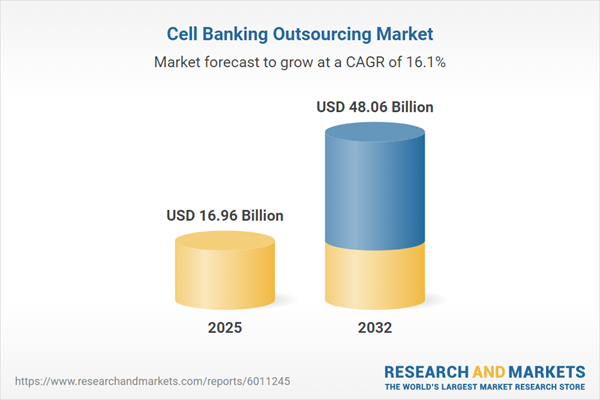Speak directly to the analyst to clarify any post sales queries you may have.
Cell banking outsourcing is becoming essential for biopharma organizations seeking operational agility, scalability, and compliance in the production and storage of critical cell lines. This report addresses key trends, regulatory drivers, and evolving services shaping this rapidly growing global market.
Market Snapshot: Cell Banking Outsourcing Market Growth and Dynamics
The Cell Banking Outsourcing Market expanded from USD 14.57 billion in 2024 to USD 16.96 billion in 2025 and is projected to reach USD 48.06 billion by 2032, supported by a CAGR of 16.08%. This trajectory is driven by increased demand for biologics, cell-based therapies, and vaccines, alongside advancements in automation, regulatory requirements, and the need for specialized infrastructure. Biopharmaceutical companies, contract research organizations, and academic institutions are forging deeper partnerships with third-party service providers to enhance reproducibility, streamline processes, and manage rising data complexity.
Scope & Segmentation
This research delivers a precise analysis of the cell banking outsourcing market by service type, cell platforms, application areas, end user profiles, and regional distribution. Segmentation enriches strategic planning and competitive benchmarking.
- Service Type: Cell expansion services, including custom and standard protocols; logistics services such as cold chain and inventory management; quality control testing (genetic characterization, safety, viability); and comprehensive storage services.
- Cell Type: Mammalian cells (CHO, hybridoma, NS0), microbial cells (E coli, yeast), and stem cells (hematopoietic, induced pluripotent, mesenchymal).
- Applications: Biopharmaceutical manufacturing (MAb and protein therapeutics); gene therapy (AAV-based, lentiviral); regenerative medicine (cell therapy, tissue engineering); and vaccine production (recombinant and viral platforms).
- End Users: Academic institutes, large and small biotechnology companies, clinical and preclinical contract research organizations, and pharmaceutical companies.
- Regions: Americas (North America and Latin America), Europe, Middle East, Africa, and Asia-Pacific, with a focus on country-level trends and infrastructure development.
- Key Companies: Coverage of industry leaders—Lonza Group AG, Thermo Fisher Scientific Inc., Merck KGaA, Cytiva Uppsala AB, Fujifilm Diosynth Biotechnologies UK Limited, WuXi AppTec Co., Ltd., AGC Biologics Inc., Catalent, Inc., Cobra Biologics Group Limited, and Selexis SA.
- Technologies: Automation, digitalization, robotics, advanced cryopreservation, single use systems, and sustainability-driven innovations.
Key Takeaways for Senior Decision-Makers
- Strategic outsourcing addresses the operational burdens and limits of internal cell banking, allowing faster clinic timelines and reduced capital outlay.
- Integration of automation, robotics, and real-time data capture is significantly improving quality assurance and process reproducibility.
- Increasing regulatory complexity and harmonization are driving the adoption of standardized protocols and cross-border quality controls.
- Single use technologies and modular facility layouts offer greater flexibility and risk reduction, enabling providers to meet evolving cell therapy and vaccine demands.
- Regional differences shape market entry: North American leadership builds on ecosystem maturity and logistics; Asia Pacific sees robust growth from governmental investment and expanding infrastructure.
- Strategic partnerships, facility expansions, and proprietary quality control technologies create differentiation among leading service providers.
Tariff Impact on Supply Chains
Recent U.S. tariff changes have introduced additional duties on cell banking supplies, prompting a shift toward diversified sourcing strategies and expanded domestic capabilities. Cold chain networks are adapting to offset potential delays and manage compliance risks, while collaborative efforts aim to streamline customs processes and maintain supply continuity.
Methodology & Data Sources
This report combines primary research—via structured interviews with senior executives across the biopharma ecosystem—with thorough reviews of scientific publications, regulatory documents, and white papers. Analytical frameworks, including SWOT and PESTEL, provide qualitative insights alongside cross-verified quantitative data.
Why This Report Matters
- Enables executive-level decision making with precise segmentation, up-to-date technology trends, and evolving regulatory landscapes.
- Provides actionable intelligence for supply chain risk mitigation, investment prioritization, and partner selection.
- Highlights opportunities for competitive differentiation in both established and emerging markets through operational and digital innovation.
Conclusion
Strategic outsourcing in cell banking is key for organizations aiming to accelerate therapeutic development while remaining agile in a shifting regulatory and operational landscape. This report delivers critical insights, helping leaders adapt and thrive as the market’s complexity and growth increase.
Additional Product Information:
- Purchase of this report includes 1 year online access with quarterly updates.
- This report can be updated on request. Please contact our Customer Experience team using the Ask a Question widget on our website.
Table of Contents
3. Executive Summary
4. Market Overview
7. Cumulative Impact of Artificial Intelligence 2025
List of Figures
Samples

LOADING...
Companies Mentioned
The key companies profiled in this Cell Banking Outsourcing market report include:- Lonza Group AG
- Thermo Fisher Scientific Inc.
- Merck KGaA
- Cytiva Uppsala AB
- Fujifilm Diosynth Biotechnologies UK Limited
- WuXi AppTec Co., Ltd.
- AGC Biologics Inc.
- Catalent, Inc.
- Cobra Biologics Group Limited
- Selexis SA
Table Information
| Report Attribute | Details |
|---|---|
| No. of Pages | 185 |
| Published | October 2025 |
| Forecast Period | 2025 - 2032 |
| Estimated Market Value ( USD | $ 16.96 Billion |
| Forecasted Market Value ( USD | $ 48.06 Billion |
| Compound Annual Growth Rate | 16.0% |
| Regions Covered | Global |
| No. of Companies Mentioned | 11 |









